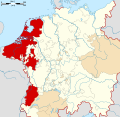This article includes a list of references, related reading, or external links, but its sources remain unclear because it lacks inline citations .(April 2025) |
The topic of this article may not meet Wikipedia's notability guideline for stand-alone lists .(April 2025) |


The County of Namur was not often an independent state, rather under the dominion of other entities like the counties of Hainaut and Flanders or the Duchy of Burgundy.
Contents
- Counts
- House of Namur
- Margraves
- House of Flanders
- House of Courtenay
- House of Luxembourg
- House of Dampierre
- House of Valois-Burgundy
- House of Habsburg
Succession is from father to son, unless otherwise noted.
